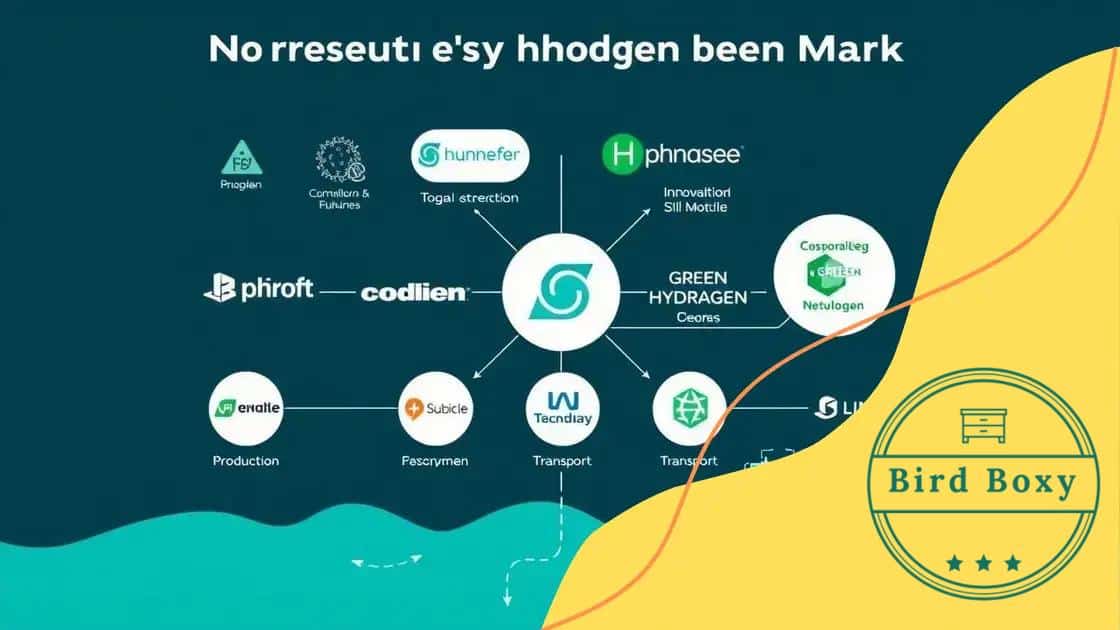Green hydrogen economy advances: the future is here

The green hydrogen economy offers significant potential for reducing emissions, enhancing energy security, and supporting economic growth, while facing challenges like high production costs and infrastructure needs.
The green hydrogen economy advances are making waves in the energy sector. Imagine a future where clean energy boosts sustainability and shifts our dependence on fossil fuels. Are you ready to explore what this means for our planet?
Understanding green hydrogen and its significance
Understanding green hydrogen is essential as we shift toward a sustainable energy future. It offers a clean alternative that can transform many industries. But what exactly is it? Green hydrogen is produced by splitting water into hydrogen and oxygen using renewable energy sources like wind and solar. This process emits no carbon, which is a major benefit.
Why is green hydrogen important?
The significance of green hydrogen lies in its potential to reduce greenhouse gas emissions and improve energy security. As the world faces climate challenges, transitioning to cleaner energy sources is crucial.
- Helps combat climate change
- Reduces reliance on fossil fuels
- Creates new economic opportunities
Moreover, green hydrogen can be stored and transported efficiently. This makes it a versatile energy carrier, unlike some renewable sources that are site-dependent. Imagine using it to power vehicles, industries, or even homes. The flexibility in its use positions green hydrogen as a key player in future energy systems.
Applications of green hydrogen
There are various applications for green hydrogen across sectors. This versatility is one of its strongest advantages. For instance, it can be used in:
- Fuel cells for transportation
- Energy storage solutions
- Industrial processes, such as steel production
In addition, it can contribute to decarbonizing hard-to-abate sectors like aviation and shipping. This growth potential is what is driving many countries to invest heavily in green hydrogen technologies.
Understanding green hydrogen enables us to envision a cleaner, more sustainable future. It’s more than just a trend; it’s a movement towards integrating renewable energy into everyday life.
Current advancements in green hydrogen technologies
Current advancements in green hydrogen technologies are paving the way for a cleaner energy future. Researchers and companies are working relentlessly to improve how we produce and use hydrogen. This ongoing innovation is critical for meeting global energy demands sustainably.
Innovative production methods
One area of focus is enhancing production methods. New techniques are being developed to create hydrogen more efficiently. These methods not only reduce costs but also increase energy output. These innovations include:
- Electrolysis improvements
- Thermochemical cycles
- Biological hydrogen production
Improving these production methods leads to higher economic viability of green hydrogen. It allows for large-scale operations that can support various industries and drive adoption.
Storage and transportation advancements
In addition to production, advancements are happening in storage and transportation technologies. Efficiently storing hydrogen is crucial, as it is less dense than other fuels. Companies are developing new techniques such as:
- Metal hydrides
- Tank innovations
- Liquid hydrogen methods
These advancements enhance safety and efficiency in transporting hydrogen. As green hydrogen gains traction, robust infrastructure will be vital for its success.
Furthermore, artificial intelligence is playing a key role in optimizing hydrogen systems. With AI, researchers can analyze data to predict efficiency and performance. This means faster advancements and better solutions for integrating hydrogen into our energy mix.
Key players in the green hydrogen market

The green hydrogen market is rapidly expanding, attracting numerous key players who are striving to innovate and lead in this field. These companies are involved in various aspects of hydrogen production, storage, and application. Understanding who these major contributors are can help us see the future of clean energy.
Leading companies in production
Several major companies have positioned themselves at the forefront of green hydrogen production. These companies are investing in technology and infrastructure to create sustainable hydrogen solutions. Some notable players include:
- Siemens Energy
- Air Products and Chemicals
- ITM Power
These firms focus on enhancing electrolyzer technology to increase efficiency and reduce costs, which is vital for the broader adoption of hydrogen energy.
Innovators in storage and transport
Storage and transportation are as critical as production in the hydrogen ecosystem. Companies like Nikola Corporation are innovating in hydrogen fuel cell technology for transportation, making it easier to integrate hydrogen as a fuel source. Likewise, these companies are developing:
- New storage solutions
- Efficient transportation networks
- Partnerships for infrastructure development
By collaborating with governments and industries, they are helping to create a robust framework needed for a thriving green hydrogen economy.
Moreover, governments around the world are backing many of these initiatives. Funding and supportive policies are encouraging private-sector investment. This combined effort indicates a strong commitment to advancing the hydrogen sector.
With significant investments from both the private and public sectors, the green hydrogen market is poised for substantial growth. Keeping an eye on these key players can help stakeholders understand trends and shifts within this evolving energy landscape.
Challenges facing the green hydrogen economy
The green hydrogen economy faces several significant challenges that must be addressed for it to thrive. While the potential for clean energy is immense, overcoming these obstacles will be crucial for widespread adoption. One primary challenge is the high cost of production.
Cost of production
Producing hydrogen through renewable sources can be more expensive compared to fossil fuel alternatives. Factors that contribute to these costs include:
- Electrolyzer technology expenses
- Renewable energy source availability
- Infrastructure development needs
These higher production costs can deter investments and slow progress in the green hydrogen sector.
Infrastructure and technological barriers
Another major challenge is the lack of existing infrastructure to support the hydrogen economy. Creating a network that allows for the storage and transport of hydrogen safely is critical for its success. This involves building new pipelines, storage facilities, and refueling stations.
Additionally, current technologies for hydrogen production and storage may not be efficient enough to meet growing demands. Companies are actively researching better methods, but progress takes time.
Market acceptance and regulatory hurdles
Market acceptance is also a key barrier. Many industries are still heavily reliant on fossil fuels, making it hard to transition to green hydrogen. Companies and governments need to collaborate to create incentives and policies that encourage this shift.
Regulatory frameworks can also pose challenges. Currently, regulations around hydrogen production and use can be inconsistent across regions. Developing a uniform regulatory approach will help streamline the process and boost investor confidence.
Addressing these challenges is critical to unlocking the full potential of the green hydrogen economy. Ongoing innovation and collaboration among stakeholders will be essential as we move toward a cleaner energy future.
Future prospects of green hydrogen and its impact on the environment
The future prospects of green hydrogen look promising, with vast potential to impact the environment positively. As the world shifts towards sustainable energy sources, hydrogen is emerging as a key player. Its ability to provide clean energy could reshape various industries and reduce carbon footprints.
Environmental benefits
One of the most significant advantages of green hydrogen is its potential to reduce greenhouse gas emissions. When used as a fuel, hydrogen produces only water vapor as a byproduct. This characteristic makes it an excellent alternative to fossil fuels.
- Reduces air pollution in urban areas
- Supports the decarbonization of hard-to-replace industries
- Contributes to climate change mitigation efforts
By replacing conventional energy sources with hydrogen, we can lessen the reliance on carbon-heavy fuels and combat climate change more effectively.
Economic growth and job creation
The expansion of the green hydrogen market is likely to stimulate economic growth and create jobs. As new technologies emerge, they will require skilled workers for development, production, and maintenance.
Various sectors, including transportation, manufacturing, and energy, will benefit from this shift. For example, the development of hydrogen fuel cells could revolutionize public transport, leading to cleaner cities and improved air quality.
Investments in hydrogen infrastructure are also expected to drive economic activity. Building pipelines, refueling stations, and storage facilities will create jobs and stimulate local economies.
Global energy transition
As countries aim for net-zero targets, green hydrogen will play a crucial role in the global energy transition. Many nations have already developed plans to integrate hydrogen into their energy systems.
This transition can help diversify energy sources, improve energy security, and develop resilient economies. Moreover, it positions countries to lead in the emerging hydrogen economy, presenting an opportunity for international collaboration and innovation.
By pursuing the development of green hydrogen, we can pave the way for a sustainable future, benefitting both the environment and our economies.
FAQ – Frequently Asked Questions about Green Hydrogen Economy
What is green hydrogen?
Green hydrogen is hydrogen produced using renewable energy sources, creating zero carbon emissions during the process.
What are the main benefits of green hydrogen?
The main benefits include reducing greenhouse gas emissions, improving air quality, and providing a sustainable energy source.
How can green hydrogen contribute to job creation?
As the green hydrogen market expands, it creates new jobs in research, production, technology, and infrastructure development.
What challenges does the green hydrogen economy face?
Challenges include high production costs, lack of infrastructure, market acceptance, and regulatory hurdles.






